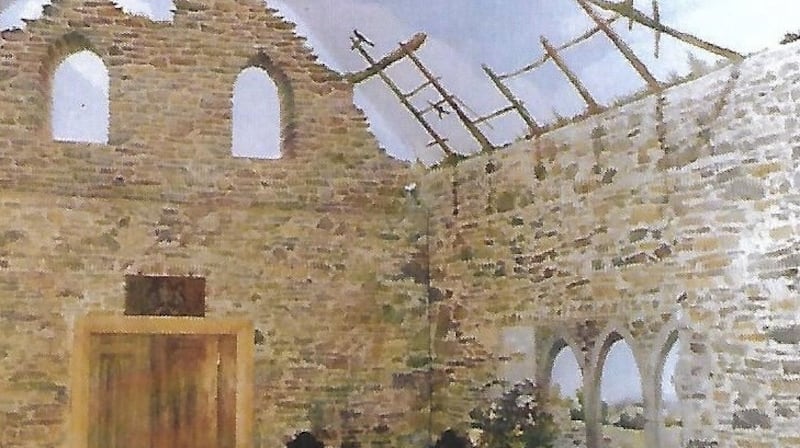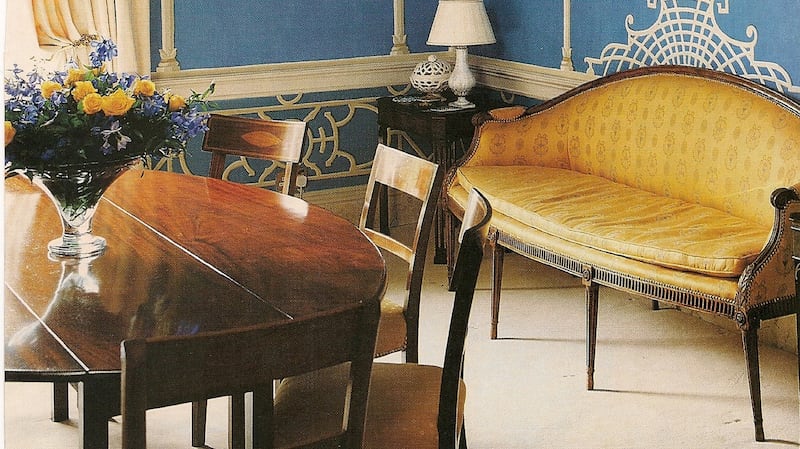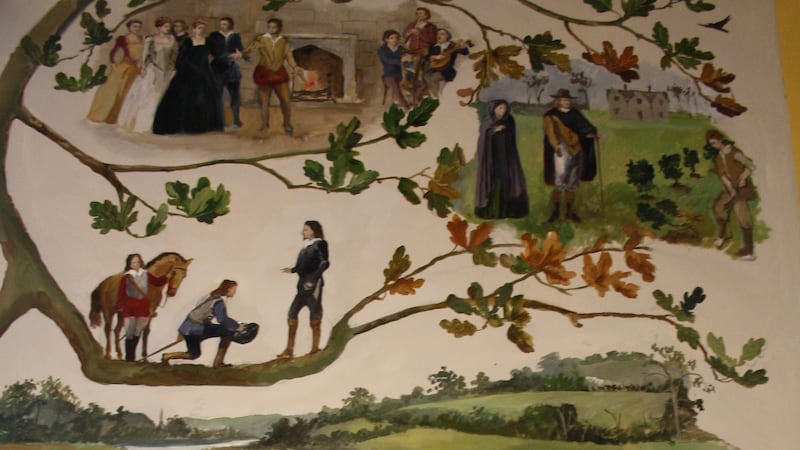A window looks out on to a medieval scene in which horses munch at hay and hounds get ready to hunt. Elsewhere, flowers burst lusciously from an urn in an alcove, trailing up walls and across a ceiling. Italianate ruins line the hallway of a house in London. None of these wonderful scenes is real. They’re the work of Irish artist Michael Dillon, whose mural painting has taken him around the world, from town houses to country estates, restaurants to mountain lodges, houses in Africa to National Trust properties across the UK.
He’s painted images in Harrods, while a panel he created for the restaurant at Fortnum & Mason sold at Bonham’s for more than €10,000. So how does an artist from Termonfeckin come by such a career? The answer isn’t straightforward. Dillon, the youngest son of Lord and Lady Dillon, grew up at Rath House in Co Louth, and he didn’t start painting until he was in his late 20s.
“I studied agriculture and worked in farming first,” he says, although he’d also drawn and painted as a child. “Most of my family are fairly talented that way. My mother painted, not professionally, and my grandmother too. I’m the last of eight, and I was always quite shy,” he tells me. “I wasn’t nearly as gregarious as my twin sister, and I used to love to disappear and draw wading birds down at the river.”

It’s hard to imagine that shyness as we talk. He’s witty and charming, tall, with light brown hair turning to pepper and salt at the temples. And while he has a slightly reticent, self-deprecating manner, it’s the kind that’s common with a certain type of person confident in their talents. He laughs frequently as he talks, in the kind of conspiratorial way that makes you smile along with him. But he also knows what he wants, and that has helped him with clients and commissions. Emily Naper of Lough Crew House remembers her first meeting with Dillon, “he came here on a bus, a friend was picking him up, and he said ‘I’d love to do your hallway, can I paint for you?’”
Grecian themes
A series of Grecian themes emerged, “he dreams them up in his head and takes it from there,” Naper says. Dillon went on to paint the sets for the Lough Crew opera series, and then transform the former stables to create a wonderful wedding venue at the house. “It’s a beautiful story,” says Naper. “It just worked really well.”
But that’s getting ahead of events. Before learning agriculture at Gurteen, Dillon tried two terms of French and Latin at Trinity, which didn’t work out, and then went farming in Ireland, New Zealand, England and France, which did. Did he have a yen for painting even then? “I always loved putting emulsion on walls,” he says, laughing. “Whitewashing the stables. And I liked doing plans for farm yards and drawing cows’ stomachs, which was part of agricultural science.”
Then, out of the blue, Dillon’s brother-in-law, Irish artist and decorator Alec Cobbe, whose family had sold Newbridge House to Dublin County Council, invited Dillon to help him with the recreation of the Chinese wallpaper at Newbridge. “Basically, I learned with him on the job.”

It sounds wonderfully haphazard, with the children, and Dillon’s wife, Henrietta, helping, but the results are extraordinarily beautiful. “I didn’t know what I was doing to begin with, but I had a fair bit of free time,” he laughs wryly, “as I wasn’t always employed . . .” Anyway, I’d go to galleries and houses to look at the paintings, to see how they did the marbling on columns, that sort of thing. But I always had a confidence about drawing.”
Amazing speed
Alexander Robertson of Huntington Castle in Co Carlow, where Dillon is currently working on a fresh set of murals, describes how that confidence enables the artist to translate ideas into huge scenes that draw you in and transport you to other places in a glorious moment. “He has this amazing speed. We have lots of painters in our family, and they might work on a landscape for weeks, but Michael works, literally, in days, and it’s rendered so well. His style is nice and fresh, and if you’re not sure about what you want, he’s very good at making little sketches, to show you an idea, to guide you through the process.”
While he does advertise, in publications such as the Racing Post, most of Dillon's work comes from word of mouth. There are the murals in the folly at Ballymaloe, more in Mount Juliet, scenes on walls in Mustique and in the rooms of a hunting lodge in Zimbabwe, a toilet in Co Kilkenny – "basically a lavatory with monkeys riding horses," he says. "It's whimsical and charming. It's so you don't have to rely on magazines to pass the time . . ."

There’s a certain network of wealthy people with incredible houses who visit one another and spread the word. Sometimes Dillon paints directly on to the walls, but these days he prefers to work using acrylics or oil on panels or huge canvases in one of his studios, in Dorset and in Co Wexford, completing them on site, wherever the project happens to be. “Paradoxically the murals on canvas are more enduring, in several cases I’ve taken them down and moved them, when the owners have moved – for example from London to the south of France.
So how much does it cost to transform your home, to provide a blank wall with a view? “It’s hard to give a ‘ball park’ figure,” Michael says. “Jobs vary so much.” Instead, he’ll produce a painted design to illustrate his proposal, and calculate a fee based on the scale and time estimated to execute the commission. “It does vary considerably,” he says.
Bored or lonely
Does he ever get bored and lonely working away on his own in lofty halls and huge empty rooms? “No, sometimes I get people to help – if I’m doing Pompeii, with lots of borders. I don’t get bored, but I do get lonely sometimes. Like any job there’s the golden moments, and then there are the others. I listen to classical music while I work, and occasionally,” he laughs, “country and western.”
He describes an idyllic life of working around the world, conjuring scenes in luxurious beauty spots. Has he ever had any disasters? Dillon stops to think. “Hideous mistakes? Yes, though the only one I’d care to reveal . . .” he tails off, not sure how many of the beans to spill. I can imagine that you need an enormous amount of reticence and tact to continue working so successfully in his world of references and recommendations.
“Go on,” I persuade. “Well, I was painting in a bathroom, a grand bathroom in England, with views of Morocco and ships and things. The husband and wife were included in the mural. I had him sitting up in the window sill, amongst some 18th-century musicians, holding wads of money, paying everyone. His wife . . .” he stops to think again, before resuming. “Anyway, she asked me to paint on something – it may have been that she hadn’t got a towel fully on her top.”
That’s the beauty of paint. Mistakes can be rectified, revisions made with a dab of a brush. But what if he’s asked to do something truly ghastly? “Nothing’s ghastly, because I can interpret it in my own way. People know my style, and anything can be turned. Anything can be made beautiful. I’m not being tactful,” he insists. “I look at any job and I’m never not interested. If people bother to ring me up, there’s a way. If someone’s happy with what you do, and they praise you, what could be better?”
Painter’s passion
Both Naper and Robertson agree about what makes Dillon such a remarkable artist. “He’s a joy to have around,” says Robertson. “It’s an incredible gift to have, to conjure up these scenes from his head,” adds Naper. “His ability is very unique. And he’s a very special person, he’s a good friend now. He loves Ireland and his painting brings him back, he’s disciplined and passionate about what he does,” she pauses, adding “I’d better keep dreaming up ideas to work with him . . .”

Both agree that Dillon has a unique manner, and a brilliant facility. "I think it's because he was born and raised in Ireland," says Robertson. "It's a lovely informal and relaxed style. Sometimes continental and British artists can be quite brittle and formal, maybe primadonnas, but that's not Michael. Who'd have thought an old boy from Gurteen agricultural college would be painting these beautiful murals around the world? He's quite happy to chat with a farmer about the heifers in his field, or with a multimillionaire about bas relief and frescoes."
Rath House, Dillon’s old family home has now been sold. Does he miss it? “No, that was when I was in France. Anyway, when you go back to a house, it all seems smaller, and now I’m used, in a way, to working with bigger rooms. And some smaller ones too,” he pauses, remembering his loo with a view. Does that mean he gets house envy for the great spaces he works in these days? “No, none of that. I’m happy to look, it’s nice to be there, and then move on somewhere else.”
Alongside his murals, Dillon also paints furniture, and works for exhibition, making pieces he describes as “excursions into fantasy”. Watch out for something transformative in a house near you.









